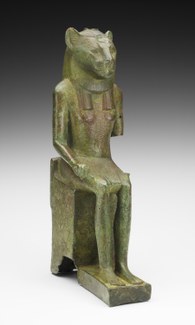Statuette of Horus or Maahes

The association of felines with kingship and divinity began early in pharaonic history when images of lions decorated sculpted reliefs of pharaohs defeating their enemies, and ornamented tombs and shrines. Sculpted and painted lion heads also adorned royal thrones and embalming beds, attesting to the fundamental role that lions played as guardians to the pharaohs and the souls of the deceased.
Under the Ptolemies the lion’s divine nature was emphasized by the prominence of cults to female and male leontomorphic divinities. In this period the city of Leontopolis (“City of Lions”) in the Nile Delta became the center of worship to Bastet and Shekhmet, lion goddesses known as the Eye of Ra, and to Maahes, a god often associated with Ptolemaic Horus, as shown by this statuette.
Gruel Mary. When the Greeks Ruled: Egypt after Alexander the Great. The Genesis of the Exhibition at the Art Institute of Chicago. In: R. Casagrande-Kim, ed. When the Greeks Ruled Egypt: From Alexander the Great to Cleopatra. ISAW, New York 2014. 26, no. 104.